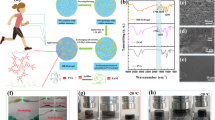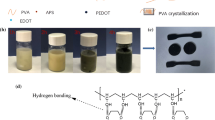Abstract
Biocompatible and multifunctional stretchable hydrogels have attracted growing interests for applications including electronic skin and soft robotics. This paper presents a conductive and humidity sensitive hydrogel formed by poly (vinyl alcohol) (PVA) and poly (vinylpyrrolidone) (PVP). Different from previous approaches where microwave-assisted aldol condensation reactions are needed to form the material, in this work, we demonstrate forming the hydrogel through only freeze–thaw process. The resulting hydrogel features a gauge factor (~ 0.8), which is higher than that of the strain sensor fabricated through traditional approach during the strain range up to 40%. Furthermore, the structural, elastic, thermal and electrical properties of the polymer blend are evaluated so the operating environment can be identified. Our experimental results show that elasticity of the blend reduces in air due to drying that cannot be completely restored. Moreover, the conductivity of the hydrogel changes with different ambient temperatures and humidity. Finally, the hydrogel is explored as a humidity sensor.








Similar content being viewed by others
References
Fu X, Wang L, Zhao L, Yuan Z, Zhang Y, Wang D, Wang D, Li J, Li D, Shulga V, Shen G, Han W (2021) Controlled assembly of mxene nanosheets as an electrode and active layer for high-performance electronic skin. Adv Func Mater 31(17):2010533
Sachyani Keneth E, Kamyshny A, Totaro M, Beccai L, Magdassi S (2021) 3D printing materials for soft robotics. Adv Mater 33(19):2003387
Yi Y, Chiao M, Wang B (2021) An electrochemically actuated drug delivery device with in-situ dosage sensing. Smart Mater Struct 30(5):055003
Lu L, Jiang C, Hu G, Liu J, Yang B (2021) Flexible noncontact sensing for human-machine interaction. Adv Mater 33(16):2100218
Yi Y, Samara A, Wang B (2021) A new approach for an ultra-thin piezoresistive sensor based on solidified carbon ink film. J Mater Sci 56(1):607–614. https://doi.org/10.1007/s10853-020-05309-8
Yi Y, Wang B, Bermak A (2019) A low-cost strain gauge displacement sensor fabricated via shadow mask printing. Sensors 19(21):4713
Zhang W, Feng P, Chen J, Sun Z, Zhao B (2019) Electrically conductive hydrogels for flexible energy storage systems. Prog Polym Sci 88:220–240
Kang J, Tok JBH, Bao Z (2019) Self-healing soft electronics. Nature Electronics 2(4):144–150
Pita-López ML, Fletes-Vargas G, Espinosa-Andrews H, Rodríguez-Rodríguez R (2021) Physically cross-linked chitosan-based hydrogels for tissue engineering applications: a state-of-the-art review. Eur Polym J 145:110176
Yokoyama F, Masada I, Shimamura K, Ikawa T, Monobe K (1986) Morphology and structure of highly elastic poly (vinyl alcohol) hydrogel prepared by repeated freezing-and-melting. Colloid Polym Sci 264(7):595–601
Lu Y, Qu X, Zhao W, Ren Y, Si W, Wang W, Wang Q, Huang W, Dong X (2020) Highly stretchable, elastic, and sensitive MXene-based hydrogel for flexible strain and pressure sensors. Research, 2038560
Bercea M, Darie RN, Niţă LE, Morariu S (2011) Temperature responsive gels based on pluronic F127 and poly (vinyl alcohol). Indus Eng Chem Res 50(7):4199–4206
Fechine GJM, Barros JAG, Catalani LH (2004) Poly (N-vinyl-2-pyrrolidone) hydrogel production by ultraviolet radiation: new methodologies to accelerate crosslinking. Polymer 45(14):4705–4709
Zheng Y, Huang X, Wang Y, Xu H, Chen X (2009) Performance and characterization of irradiated poly (vinyl alcohol)/polyvinylpyrrolidone composite hydrogels used as cartilages replacement. J Appl Polym Sci 113(2):736–741
Bercea M, Morariu S, Rusu D (2013) In situ gelation of aqueous solutions of entangled poly (vinyl alcohol). Soft Matter 9(4):1244–1253
Rajesh K, Crasta V, Kumar NR, Shetty G, Rekha PD (2019) Structural, optical, mechanical and dielectric properties of titanium dioxide doped PVA/PVP nanocomposite. J Polym Res 26(4):1–10
Suciu AN, Iwatsubo T, Matsuda M, Nishino T (2004) A study upon durability of the artificial knee joint with PVA hydrogel cartilage. JSME Int J, Ser C 47(1):199–208
Biswas A, Willet JL, Gordon SH, Finkenstadt VL, Cheng HN (2006) Complexation and blending of starch, poly (acrylic acid), and poly (N-vinyl pyrrolidone). Carbohyd Polym 65(4):397–403
Wang L, Zeng R, Li C, Qiao R (2009) Self-assembled polypeptide-block-poly (vinylpyrrolidone) as prospective drug-delivery systems. Colloids Surf B 74(1):284–292
Leiva A, Quina FH, Araneda E, Gargallo L, Radić D (2007) New three-arm amphiphilic and biodegradable block copolymers composed of poly (ε-caprolactone) and poly (N-vinyl-2-pyrrolidone). Synthesis, characterization and self-assembly in aqueous solution. J Coll Interf Sci 310(1):136–143
Teodorescu M, Morariu S, Bercea M, Săcărescu L (2016) Viscoelastic and structural properties of poly (vinyl alcohol)/poly (vinylpyrrolidone) hydrogels. RSC Adv 6(46):39718–39727
Leone G, Consumi M, Greco G, Bonechi C, Lamponi S, Rossi C, Magnani A (2011) A PVA/PVP hydrogel for human lens substitution: Synthesis, rheological characterization, and in vitro biocompatibility. J Biomed Mater Res B Appl Biomater 97(2):278–288
Nishio Y, Haratani T, Takahashi T (1990) Miscibility and orientation behavior of poly (vinyl alcohol)/poly (vinyl pyrrolidone) blends. J Polym Sci, Part B Polym Phys 28(3):355–376
Shi Y, Xiong D, Liu Y, Wang N, Zhao X (2016) Swelling, mechanical and friction properties of PVA/PVP hydrogels after swelling in osmotic pressure solution. Mater Sci Eng, C 65:172–180
Awadallah-F A (2014) Five years in vitro study of (poly vinyl alcohol/poly vinyl pyrrolidone/poly acrylic acid) hydrogel to mimic the knee joint meniscus. Polym Adv Technol 25(5):581–587
Trung TQ, Lee NE (2016) Flexible and stretchable physical sensor integrated platforms for wearable human-activity monitoringand personal healthcare. Adv Mater 28(22):4338–4372
Fiorillo AS, Critello CD, Pullano SA (2018) Theory, technology and applications of piezoresistive sensors: a review. Sens Actuators A 281:156–175
Ding Y, Xu T, Onyilagha O, Fong H, Zhu Z (2019) Recent advances in flexible and wearable pressure sensors based on piezoresistive 3D monolithic conductive sponges. ACS Appl Mater Interf 11(7):6685–6704
Surmenev RA, Chernozem RV, Pariy IO, Surmeneva MA (2021) A review on piezo-and pyroelectric responses of flexible nano-and micropatterned polymer surfaces for biomedical sensing and energy harvesting applications. Nano Energy 79:105442
Liu YJ, Fu LH, Liu S, Meng LY, Li YY, Ma MG (2016) Synthetic self-assembled homogeneous network hydrogels with high mechanical and recoverable properties for tissue replacement. J Mater Chem B 4(28):4847–4854
Ma R, Xiong D, Miao F, Zhang J, Peng Y (2009) Novel PVP/PVA hydrogels for articular cartilage replacement. Mater Sci Eng C 29(6):1979–1983
Chen YN, Peng L, Liu T, Wang Y, Shi S, Wang H (2016) Poly (vinyl alcohol)–tannic acid hydrogels with excellent mechanical properties and shape memory behaviors. ACS Appl Mater Interf 8(40):27199–27206
Choudhary S, Sengwa RJ (2018) ZnO nanoparticles dispersed PVA–PVP blend matrix based high performance flexible nanodielectrics for multifunctional microelectronic devices. Curr Appl Phys 18(9):1041–1058
Hodge RM, Edward GH, Simon GP (1996) Water absorption and states of water in semicrystalline poly (vinyl alcohol) films. Polymer 37(8):1371–1376
Rajeswari N, Selvasekarapandian S, Karthikeyan S, Sanjeeviraja C, Iwai Y, Kawamura J (2013) Structural, vibrational, thermal, and electrical properties of PVA/PVP biodegradable polymer blend electrolyte with CH3COONH4. Ionics 19(8):1105–1113
Price DC, Davenport WG (1980) Densities, electrical conductivities and viscosities of CuSO 4/H 2 SO 4 solutions in the range of modern electrorefining and electrowinning electrolytes. Metall Trans B 11(1):159–163
Liu Z, Liu J, Zhang J, Zheng B, Ren X, Long Y, Fang L, Ou R, Liu T, Wang Q (2020) Highly compressible hydrogel sensors with synergistic long-lasting moisture, extreme temperature tolerance and strain-sensitivity properties. Mater Chem Front 4(11):3319–3327
Holloway JL, Spiller KL, Lowman AM, Palmese GR (2011) Analysis of the in vitro swelling behavior of poly (vinyl alcohol) hydrogels in osmotic pressure solution for soft tissue replacement. Acta Biomater 7(6):2477–2482
Funding
This research received no external funding.
Author information
Authors and Affiliations
Corresponding author
Ethics declarations
Conflict of interest
The authors declare that they have no competing financial interest.
Additional information
Handling Editor: Chris Cornelius.
Publisher's Note
Springer Nature remains neutral with regard to jurisdictional claims in published maps and institutional affiliations.
Rights and permissions
About this article
Cite this article
Yi, Y., Chiao, M., Mahmoud, K.A. et al. Preparation and characterization of PVA/PVP conductive hydrogels formed by freeze–thaw processes as a promising material for sensor applications. J Mater Sci 57, 8029–8038 (2022). https://doi.org/10.1007/s10853-022-07179-8
Received:
Accepted:
Published:
Issue Date:
DOI: https://doi.org/10.1007/s10853-022-07179-8




